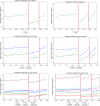The road to recovery: impact of COVID-19 on healthcare utilization in South Korea in 2016-2022 using an interrupted time-series analysis
- PMID: 37780633
- PMCID: PMC10541464
- DOI: 10.1016/j.lanwpc.2023.100904
The road to recovery: impact of COVID-19 on healthcare utilization in South Korea in 2016-2022 using an interrupted time-series analysis
Abstract
Background: The COVID-19 pandemic substantially disrupted healthcare utilization patterns, globally. South Korea had been praised widely in its efforts to contain the spread of the pandemic, which may have contributed to a significantly smaller reduction in healthcare utilization compared to neighboring countries. However, it remains unknown how the COVID-19 pandemic impacted utilization patterns across population sub-groups, particularly vulnerable patient groups in South Korea. This paper quantifies the changes in healthcare utilization attributable to COVID-19 and the COVID-19 vaccination by sub-groups.
Methods: An interrupted time series analysis was conducted to examine the impact of COVID-19 on healthcare utilization in South Korea from January 2016 to December 2022 using aggregated patient-level data from the national health insurance system that accounts for 99% of all healthcare services in South Korea. We applied negative binomial models adjusting for seasonality and serial correlation. Falsification tests were conducted to test the validity of breakpoints. Stratified analyses by type of healthcare services, age, sex, income level, health facility type, and avoidable/non-avoidable hospitalizations was performed, and we assessed differences in utilization trends between population groups across three phases of the pandemic.
Findings: In early 2020, the COVID-19 pandemic caused a reduction in monthly volume of outpatient utilization by 15.7% [95% CI 13.3%-18.1%, p < 0.001] and inpatient utilization by 11.6% [10.1%-13.0%, p < 0.001]. Most utilization recovered and rebounded to pre-COVID-19 levels as of December 2022 although variations existed. We observed heterogeneity in the magnitude of relative changes in utilization across types of services, varying from a 42.7% [36.8%-48.0%, p < 0.001] decrease for pediatrics, a 23.4% [20.1%-26.5%%, p < 0.001] reduction in utilization of public health centers, and a 24.2% [21.2%-27.0%, p < 0.001] reduction in avoidable hospitalizations compared to the pre-pandemic period. Contrary to global trends, health utilization among the elderly population (65 and older) in South Korea saw only marginal reductions compared to other age groups. Similarly, Medicaid patients and lower income groups experienced a smaller reduction compared to higher income groups.
Interpretation: The impact of the COVID-19 pandemic on healthcare utilization in South Korea was less pronounced compared to the global average. Utilization of vulnerable populations, including adults over 65 years old and lowest-income groups reduced less than other type of patients.
Funding: No funding.
Keywords: Age; Aging population; Avoidable/non-avoidable hospitalizations; Elderly; Health facility type; Health service utilization; Impact of COVID-19; Income level; Interrupted time-series analysis; Low-income; Low-income level; Medicaid; National health insurance service; Negative binomial model; Road to recovery; Sex; South Korea; Type of healthcare services; Vulnerable populations.
© 2023 The Author(s).
Conflict of interest statement
The authors whose names are listed immediately above certify that they have NO affiliations with or involvement in any organization or entity with any financial interest (such as honoraria; educational grants; participation in speakers’ bureaus; membership, employment, consultancies, stock ownership, or other equity interest; and expert testimony or patent-licensing arrangements), or non-financial interest (such as personal or professional relationships, affiliations, knowledge or beliefs) in the subject matter or materials discussed in this manuscript.
Figures
References
-
- Amanda K. IHEA.; 2023. Forgone health care during the COVID-19 pandemic: changes from 2020 to 2021 in 25 developing countries.
-
- Organization, W.H . 2020. The impact of the COVID-19 pandemic on noncommunicable disease resources and services: results of a rapid assessment.
LinkOut - more resources
Full Text Sources


